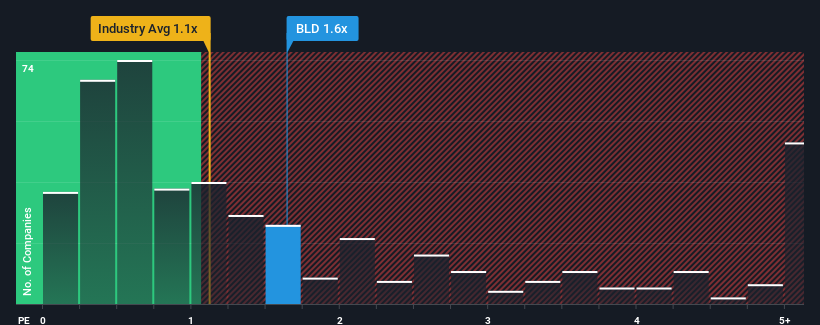It's not a stretch to say that Boral Limited's (ASX:BLD) price-to-sales (or "P/S") ratio of 1.6x right now seems quite "middle-of-the-road" for companies in the Basic Materials industry in Australia, where the median P/S ratio is around 1.7x. Although, it's not wise to simply ignore the P/S without explanation as investors may be disregarding a distinct opportunity or a costly mistake.
See our latest analysis for Boral

What Does Boral's Recent Performance Look Like?
With revenue growth that's superior to most other companies of late, Boral has been doing relatively well. It might be that many expect the strong revenue performance to wane, which has kept the P/S ratio from rising. If the company manages to stay the course, then investors should be rewarded with a share price that matches its revenue figures.
Want the full picture on analyst estimates for the company? Then our free report on Boral will help you uncover what's on the horizon.How Is Boral's Revenue Growth Trending?
There's an inherent assumption that a company should be matching the industry for P/S ratios like Boral's to be considered reasonable.
If we review the last year of revenue growth, the company posted a terrific increase of 17%. Revenue has also lifted 11% in aggregate from three years ago, mostly thanks to the last 12 months of growth. Therefore, it's fair to say the revenue growth recently has been respectable for the company.
Looking ahead now, revenue is anticipated to climb by 4.7% per annum during the coming three years according to the analysts following the company. That's shaping up to be materially lower than the 7.5% per annum growth forecast for the broader industry.
With this in mind, we find it intriguing that Boral's P/S is closely matching its industry peers. Apparently many investors in the company are less bearish than analysts indicate and aren't willing to let go of their stock right now. Maintaining these prices will be difficult to achieve as this level of revenue growth is likely to weigh down the shares eventually.
The Final Word
We'd say the price-to-sales ratio's power isn't primarily as a valuation instrument but rather to gauge current investor sentiment and future expectations.
Our look at the analysts forecasts of Boral's revenue prospects has shown that its inferior revenue outlook isn't negatively impacting its P/S as much as we would have predicted. When we see companies with a relatively weaker revenue outlook compared to the industry, we suspect the share price is at risk of declining, sending the moderate P/S lower. A positive change is needed in order to justify the current price-to-sales ratio.
A lot of potential risks can sit within a company's balance sheet. Our free balance sheet analysis for Boral with six simple checks will allow you to discover any risks that could be an issue.
If companies with solid past earnings growth is up your alley, you may wish to see this free collection of other companies with strong earnings growth and low P/E ratios.
Valuation is complex, but we're here to simplify it.
Discover if Boral might be undervalued or overvalued with our detailed analysis, featuring fair value estimates, potential risks, dividends, insider trades, and its financial condition.
Access Free AnalysisHave feedback on this article? Concerned about the content? Get in touch with us directly. Alternatively, email editorial-team (at) simplywallst.com.
This article by Simply Wall St is general in nature. We provide commentary based on historical data and analyst forecasts only using an unbiased methodology and our articles are not intended to be financial advice. It does not constitute a recommendation to buy or sell any stock, and does not take account of your objectives, or your financial situation. We aim to bring you long-term focused analysis driven by fundamental data. Note that our analysis may not factor in the latest price-sensitive company announcements or qualitative material. Simply Wall St has no position in any stocks mentioned.
About ASX:BLD
Boral
Operates as a vertically integrated construction materials company in Australia.
Flawless balance sheet with proven track record.
Similar Companies
Market Insights
Community Narratives



